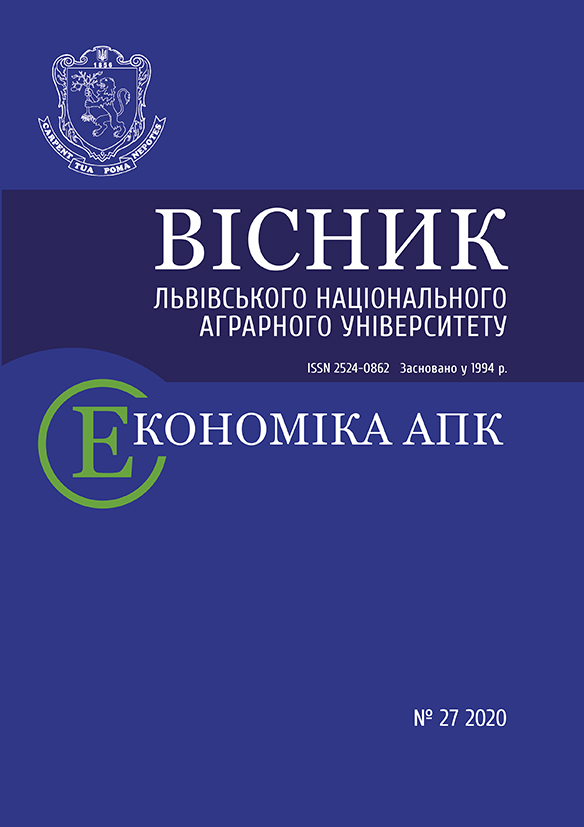Visnyk LNAU: Agronomy 2021 №25: 49-54
INFLUENCE OF THE FEEDING AREA OF WINTER WHEAT PLANTS ON STRUCTURAL ELEMENTS, YIELD AND GRAIN QUALITY
Lykhochvor V., Doctor of Agricultural Sciences
ORCID ID: 0000-0003-0377-6157
Bomba M., Candidate of Agricultural Sciences
ORCID ID: 0000-0001-7865-2111
Andrushko О., Candidate of Agricultural Sciences
ORCID ID: 0000-0003-3825-6960
Lviv National Agrarian University
https://doi.org/10.31734/agronomy2021.01.049
Annotation
The field research was conducted on the research field of the Department of Plant Technology of Lviv National Agrarian University to establish the optimal feeding area of winter wheat plants in 2018–2020. The following sowing methods were studied: 15×1.7 = 25 cm2 (row); 4×4 = 16 cm2; 5×5 = 25 cm2; 6×6 = 36 cm2; 7×7 = 49 cm2; 8×8 = 64 cm2; 9×9 = 81 cm2; 10×10 = 100 cm2. The increase of the feeding area led to a decrease of the number of plants from 428 pcs/m2 to 86 pcs/m2, the density of productive stems - from 624 pcs/m2 to 463 pcs/m2, the increase of the coefficient of productive bushiness - from 1.5 to 5.4, the number of grains in the ear - from 33 pieces to 40 pieces, the weight of grain - from an ear from 1.29 to 1.67 g.
The optimal combination of elements of the crop structure, which provided the highest yield, was as follows, i.e. 585 ears and 1.53 g of grain per ear were formed per 1 m2 on the feeding area of 6×6 cm, and 554 pieces and 1.64 g on the area of 7×7 cm respectively.
The yield in the experiment was high in all variants and ranged from 4.40 to 9.09 t/ha. The highest grain yield of winter wheat of the Tobak variety was formed on the feeding area of 6x6 cm (8.94 t/ha) and 7×7 cm (9.09 t/ha), which is higher than the row method of sowing by 0.90 t/ha and 1.05 t/ha respectively. Precise placement of seeds in all sowing schemes, except for 10×10 cm, provided higher yields as compared to the row method of sowing.
Grain quality indicators were high in all variants of the experiment (gluten content 26.4–27.0 % and protein 12.9–13.1 %) and changed little under the influence of feeding area.
To fully realize the potential of winter wheat yield for sowing with accurate seed placement, it is necessary to develop the appropriate technology, where special attention is paid to the dates and rates of the application of nitrogen fertilizers and retardants to intensify the bushiness process and increase the productivity of bushiness shoots.
Key words
winter wheat, feeding area, sowing rate, yield, quality
Link
- Heege G. J. The technique of sowing in the cultivation of cereals. Intensive technology of cultivation of grain crops, especially considering the technique of sowing and protection of plants. Leverkusen. Bayer, 1986. Р. 85–102.
- Lykhochvor V. V., Bomba M. I. Grain productivity of winter wheat varieties depending on fertilizer and sowings rates. Bulletin of Lviv National Agrarian University: agronomy. 2020. No. 24. Р. 51–57.
- Lykhochvor V. V. Formula for calculating the sowing rates of winter wheat seeds. Plant Health: Winter cereals – wheat, barley, rye. Series «Agronomy today». Kyiv: Press Mediа, 2016. No 4. P. 26–28.
- Lykhochvor V. V. Optimization of sowing rates of winter wheat. Agribusiness today. 2012. No. 24. P. 22–24.
- Lykhochvor V. V. Optimization of parameters of winter wheat crop structure. Agronomist. 2016. No. 4. P. 58–64.
- Lykhochvor V. V., Prots R. R. Winter wheat. Lviv: Ukrainian technologies, 2006. 216 p.
- Lykhochvor V. V. Structure of winter wheat yield: мonograph. Lviv: Ukrainian technologies, 1999. 200 p.
- Lykhochvor V. V. Yields of winter wheat varieties depending on sowing rates on different fertilizer backgrounds. Bulletin of Lviv National Agrarian University: agronomy. Lviv: Lviv. nat. agrarian. un-ty, 2018. No. 22 (1). P. 284–290.
- Petrychenko V. F., Lykhochvor V. V. Plant Growing. New technologies for growing field crops: a textbook. 5th ed., сorrected, supplemented. Lviv: Ukrainian technologies, 2020. 806 p. Pozniak V. V. Economic efficiency of growing winter wheat applying the retardant chlormequat chloride depending on the sowing rates and the level of soil fertilization. Tauria Scientific Bulletin. 2019. No. 109. Part 1. P. 95–102.
- Popov S. I., Avramenko S. V. Influence of sowing rate, precursor and fertilizer system on winter wheat yield. Myronivskyi Visnyk. 2016. Vol. 3. Р. 179–189.
- Rozhkov A. A., Bobro M. A., Ryzhyk T. V. Grain yield of soft winter wheat depending on the influence of sowing dates and sowing rates. Bulletin of Agrarian Science of the Black Sea Coast. 2016. Issue 1 (88). P. 69–80.
- Shpaar D. Cereals: cultivation, harvesting, storage and use. 4th edition, corrected. Kyiv: Zerno Publishing House, 2012. 704 p.
- Smolinskyi S., Marchenko V. How and with what row spacing to sow cereals. Agroexpert. 2016. No. 1. P. 66–69.



